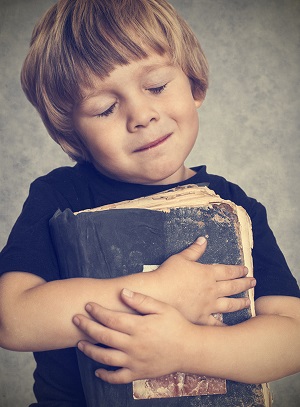 |
My family, probably like yours, has only a few pieces of tangible family history. Receipts saved by a great great grandfather. A nearly illegible diary written seventy years ago by a young soldier. Recipes with notations in my grandmother’s handwriting. Solemn photographs, mostly unidentified. Still, we recently managed to trace part of our lineage. We found it exciting to uncover a family tree reaching back dozens of generations. Maybe having a Nordic ancestor named Malcolm the Big Headed explains my protracted labor with our third child. But discovering the names of ancestors isn’t entirely satisfying. We want a wider glimpse. We long to know what sort of men and women these people were. How did they feel about the events of their time? What were the stories that made up their lives? What personal traits did they pass down to us? Our ancestors may not have left us much to go on, but chances are we’re leaving even less for our own descendants. The richest details of family history come from sources that are rarely if ever utilized these days. Families once saved newspaper clippings, but there aren’t many local newspapers reporting the details of club meetings or family reunions. Few of us are avid letter writers with copies of our correspondence. The tradition of travel journals and daily diaries is largely forgotten. We may have extensive digital material but there’s no real assurance that our videos, photos, blogs, and social media sites will be saved let alone accessible in a hundred years or more. There’s a solution. Create family memorabilia intentionally. This isn’t a one-shot deal, it’s a long- term approach. Working together on the following projects not only promotes close ties, it adds to a storehouse of rich family memories. Choose the methods that work best for your family. Write Annual Autobiographies. Each year, help your young children make a new “All About Me” book. Start with a scrapbook or blank book. Include a self-drawn portrait as well as photos. Write about favorite foods, activities, and places. Use the same prompts each year such as “What makes me happy,” “What I am good at,” “What makes me mad,” and “What I want to be when I grow up.” Don’t show surprise or dismay over any answers; just help with writing, transcribing if necessary. As your children get older, encourage them to keep up the tradition. These books are an invaluable record of growing self-awareness. You might write one of your own too! Save Online Journals. Many of us post entries on Twitter, Facebook, Google+, Tumblr, blogs —well, you know. These regular updates are a form of journaling. They detail our struggles, joys, and interests—compiling exactly the sort of material family historians adore. A simple way to preserve your blog or other online material is to turn them into books. Print out your most memorable posts on acid free paper and slide them into archival sleeves. Or bind them into books yourself (put the terms “book binding instructions” in a search engine). You may prefer to submit the pages to a custom book service such as Lulu.com, Snapfish.com, or Blog2Pring.sharedbook.com. And you might consider making copies for each family member. Keep a History Cache. Designate a special trunk or storage container as a personal history cache for each person in your family. Use it to store photos, once-favorite toys, copies of medical records, a few baby teeth, letters, artwork, stories written by your child, special ticket stubs, whatever you deem memorable. Whenever possible put items into acid-free bags, wrap fabrics in acid-free tissue, and slip papers into archival sleeves. Add important items to this cache throughout the decades. Pass Around a Family Journal. Once a month or so, your family may enjoy adding entries to a large-format, acid-free journal. This journal might include hand-drawn cartoons and sketches, observations about current events, and diary-like entries. Consider lists such as “things I want to invent,” “places I want to go,” and “people I’ll be friends with forever.” Each family member can respond to the same journal prompt such as “my idea of a perfect day,” or “the best part of my week.” Keep this activity light-hearted and non-critical to ensure that kids of all ages continue to take part. Such journals provide a messy and charming look at our unique families. Make Collaborative Scrapbooks. If you are one of the many talented scrapbookers carefully keeping photos and memorabilia, you’re ahead of the family history game. But make sure you include more than photos and themed decorations. To really capture the essence of your family you’ll want to include envelopes in your scrapbook pages where you can save letters (try having each member of the family write a letter to an older version of him or herself), lists, and notes about each child. You can also fill the pages with your child’s artwork and creative writing. Put Together a Family Zine. A family zine or newsletter is a lively way to keep your extended family and friends up-to-date on your news. Include updates, inside jokes, funny quotes from the youngest ones, photos, family trivia (measure the circumference of your heads or all the proposed names for the new goldfish), memorable moments, favorite recipes. You may create a monthly, seasonal or twice yearly issue. Encourage each child to contribute something each time. Make sure you print out plenty of copies to save on acid-free paper. Seal a Time Capsule. A time capsule is a great way to get to know what is important to each of your family members. Choose an airtight, heavy duty container if you plan to store it long-term. Ask everyone to contribute items they find personally and historically relevant. This might include photos, toys, artwork, coins, and magazines. For extra protection put each item into separate airtight acid-free bags, folders, or boxes. Include an inventory explaining the items; otherwise the significance of that plastic movie monster may be lost! You may also choose to leave a written message for whoever will open the time capsule, even if it will be your own family in thirty years. You might want to write about an ordinary day, your concerns, your views on the news, current trends, and predictions for the future. Before sealing, toss in a few desiccant gel packages (these are often found in new electronic goods or vitamin supplements) to absorb damaging moisture. It’s best to store your time capsule indoors. If it’s hidden, keep track of the location by noting its GPS coordinates. You may choose to schedule an opening at a special date or occasion, perhaps upon the birth of your first grandchild or New Year’s Day 2040. Send those GPS coordinates and plans to as many people as possible for safe keeping. Keep a Memory Jar. This is the easiest idea of all. Write the label “Memory Jar” on any large container and keep it visible. Or use a locked box with a slot. Encourage family members to scrawl memories, even a sentence or two, on any scrap of paper. Each one needs a date and name before folding it to tuck in the jar. Decide in advance when the jar will be opened. Once a year? After a few decades? As you work together on the projects you’ve chosen, you’ll find that making intentional memorabilia is fun. It’s also highly educational, builds family closeness, and creates irreplaceable resources for future enjoyment. Now that’s a legacy. Laura Grace Weldon is the author of “Free Range Learning: How Homeschooling Changes Everything” and is slowly at work on her next book. She lives with her family on Bit of Earth Farm where they raise livestock, produce, and the occasional ruckus. Hang out with her here.
| |






